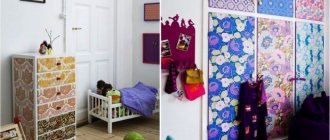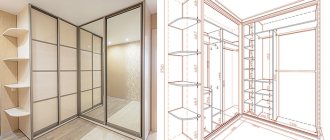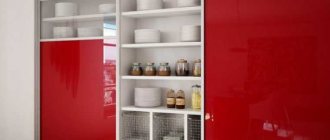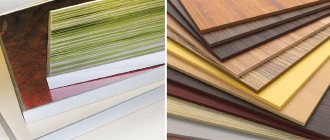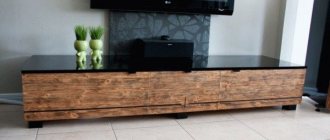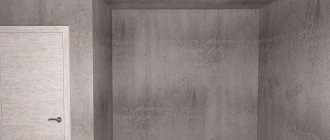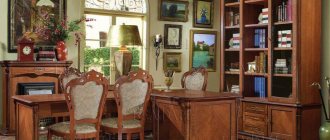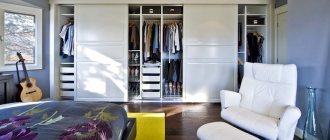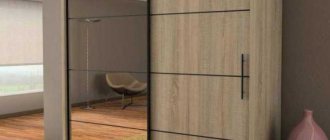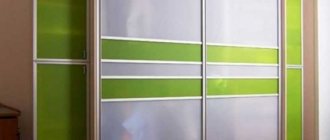The standard of living of a modern person, with due diligence, is very high. As a result, we acquire a huge number of things we need in everyday life: outerwear, underwear, accessories, interior items, some things dear to our hearts, etc. When the amount of said kitsch becomes unimaginable, and the closets placed around the apartment run out of space, we begin to think about where to put all these trinkets. The answer immediately comes to mind: we need to make a built-in wardrobe in the hallway with our own hands. Let's get started with the article in which we discuss the advantages of sliding wardrobes, the main nuances of their installation, and give detailed instructions on how to independently assemble a spacious wardrobe for a small hallway.
DIY built-in wardrobe in the hallway
Materials and tools
Before you get down to work, you first need to decide what material you plan to make the built-in wardrobe from; it depends on:
- how to build drawings;
- what tools are needed for installation;
- what assembly scheme to use to build the cabinet into the space allocated to it.
Depending on the specifics of the material, the process of arranging cabinets in niches can differ radically.
| Material | Degree of compliance with the task | Rationale | Solution |
| Tree | Not very suitable for built-in cabinet type. | The air humidity in the niche is higher relative to the room as a whole. Wooden parts may swell and warp. The reason is changes in humidity from the blank wall towards the doors. When you open the cabinet, the humidity changes sharply, which triggers negative processes. | Take straight-grained wood, without knots, strands, or cracks. The wood must be seasoned and impregnated as much as possible with a water-polymer emulsion or hot drying oil. |
| Lining | Limited fit. | Due to the fact that the frames of the doors will need to be made of wood, which is sensitive to moisture. | Use only when required by the interior design. |
| Gypsum plasterboard sheet (GKL) | Unsuitable as a basis, although it has great potential. | Heavy, brittle and low-strength material. Not suitable for the manufacture of load-bearing structures. May bend under its own weight. When installed vertically it becomes deformed. | Used for finishing only. The shelves are made in the form of a box-shaped spatial structure based on a frame. Requires putty and decorative finishing. Only standard C and U profiles with standard fasteners are suitable for the frame. |
| Laminate, MDF, fiberboard | Great choice. | Simple construction design. Minimum costs. The materials are not sensitive to changes in humidity. | Fiberboard – medium, high density. A thin bar inside a niche will quickly move. |
Wooden lining
Drywall
Tree
Chipboard
You will also need to purchase:
- self-tapping screws with dowels;
- guides and mechanism for sliding wardrobe doors;
- double sided tape;
- alcohol wipes for degreasing surfaces;
- friezes to the guides;
- mounting angles;
- hanging racks;
- rod holders.
Before installation, collect all the tools necessary for installing cabinets:
- electronic rangefinder or tape measure;
- level;
- electric jigsaw for cutting;
- screwdriver;
- screwdriver;
- electric drill for holes in the wall;
- hammer.
Before starting work, it is useful to look at the installation instructions for built-in wardrobes.
Rollers and fasteners
Guides
Materials
Design and drawing development
Before you take on cabinet drawings, you need to understand how to take measurements correctly. The niche in which you plan to install a wardrobe will not always have the correct geometric shape. That is why measurements in a niche must be carried out according to the following rules:
- first, measurements are taken along the back wall: at the top, at the middle level, at the bottom;
- then we also measure the “front part” with an indentation;
- height measurement also occurs in three positions from the “rear” and from the “front”.
Installing a built-in wardrobe without such measurements can lead to the fact that the body, made without taking into account errors and differences, either will not fit, or when trying to assemble the structure, serious gaps will be discovered. It will be a shame if the cut shelf turns out to be smaller than the required size and simply falls through. Before installing, carefully calculate all errors in order to leave allowance for installation. Sometimes it happens that the end drawing of the shelves resembles a trapezoid rather than the expected rectangle. It all depends on the quality of the walls, the density of the plaster on the inner corners of the niche.
Next we move on to the drawing. If you do not have drawing skills, it is better to contact a designer. Based on your data and wishes regarding the material, they will make a drawing of your future wardrobe in a niche. In such work, you need to remember to take into account the thickness of the material, the edges, if you want to thoroughly cover the cut points, and the margin for the mechanism of the compartment itself, which also needs to be about 10 cm.
Having detailed diagrams on hand, you can be sure that the manufacture of cabinet parts will be more accurate. Allowances left when taking into account wall errors will make the installation more accurate.
Now, as for the design of the future cabinet: without much experience in drawing up drawings and installation, give up complex radial facade designs. Here you need not just skills, but good professional experience in order to calculate and then competently assemble such a structure. Limit yourself to a simpler cabinet option that you are guaranteed to be able to control during assembly. Order all decorative elements strictly in accordance with the drawing.
How to take measurements of a built-in wardrobe?
A built-in wardrobe usually fits into an existing niche or “stretches” across the entire wall. Therefore, the accuracy of all dimensions is especially important here so that there are no gaps left anywhere. Take all measurements at three different points - this will compensate for possible unevenness in the niche.
Measure the back wall and front from the top, bottom and middle, and the height from all four corners. After all, otherwise the “backdrop” may simply not fit into the niche, and a shelf that is too small will not hold up and will fall through. In practice, it may well turn out that instead of the expected rectangle you need a trapezoid or parallelogram.
Do not forget to include in all calculations the thickness of the material and edges, as well as the compartment mechanism itself with guides, which will take about another 10 cm. It is better to study in advance on the Internet various drawings and instructions for assembling ready-made cabinets in order to visually represent the design in practice.
If you do not have extensive drawing and design experience, avoid complex elements. Radial designs, curved lines, complex geometric shapes require professionalism. But even the simplest rectangular wardrobe is quite beautiful and functional.
Sawing and fittings
If you decide to assemble a built-in wardrobe yourself, leave the sawing to a professional furniture shop. Building a high-quality drawing is half the battle; another question is whether you have the skills to cut out all the necessary parts and how long it will take you. Involving assistants in this situation is more than justified:
- furniture makers purchase materials at wholesale prices, you will have to do the same at retail prices, and this is an overpayment of at least 20 percent;
- According to your drawings, specialists using computerized equipment will cut the parts quickly and with fewer defects. Cutting on a machine is of better quality than doing it manually, even with the best saw;
- Your cuts will be edged. This will help protect parts of the built-in cabinet from moisture and excessive swelling of materials. For details that will be visible, this will give an additional decorative effect. The edge can be simple or thick with chamfers.
If you take laminate or MDF for the product, then the thickness for the body should be at least 16 mm, and for the doors - 25 mm.
As for the fittings, they can be purchased at specialized furniture stores. Before you begin installation, make sure you have everything you need.
Preparing parts
Cabinet parts
Fastening the frame
Before you begin installing the cabinet, it is useful to watch a step-by-step video of a built-in wardrobe with your own hands. Even professionals watch training programs from time to time. If you have basic experience, this will help you build a consistent algorithm of actions. A detailed description of the procedure will indicate the important nuances that built-in furniture implies. The installation instructions will allow you to follow the order of installation work and obtain a functional result.
Built-in wardrobes are different in that they do not actually have their own frame. The floor, walls and ceiling of the cabinet are created in the niche itself. In this case, the frame will mean the false panel to which the compartment guides are attached.
When attaching such a frame, it is very important to compensate for unevenness if the ceiling, floor or walls form a slope. If this is not done, the compartment door guide will tilt and movement of the doors may become impossible.
To compensate for existing gaps, MDF or laminate inlays are used. The frame is leveled and secured with self-tapping screws to the walls along with the inlays. Decoration of cracks is carried out using friezes - decorative strips that are attached to double-sided tape or glued. The frieze is pre-cut from chipboard of the same tone as the rest of the cabinet parts with allowances, which are trimmed directly during the installation process.
Measurements and drawing
Installation of frame frames
Fastening the frame
Manufacturing stages
Once the cabinet design is ready, you can begin to manufacture it. First of all, you need to cut out the furniture elements. There are some nuances here.
Preparing parts
Cutting cabinet elements is a delicate, complex, and responsible process. Before you make the cutting yourself, you need to weigh all the pros and cons of such a decision. In the absence of suitable tools and professional skills, it is better to entrust the work to professionals, otherwise there is a risk of damaging the materials and incurring losses. The advantages of this solution:
- carpenters can use their own material, this reduces costs by 20%;
- According to the provided diagrams of the cabinet filling body, workers will saw the elements on a computerized machine - accurately, without defects or errors;
- cutting will be carried out quickly, without unnecessary time and labor costs;
- Furniture makers will trim the cuts with a special polymer material; it will protect the parts from moisture penetration and increase their aesthetics.
The edges are flat; they are glued to the ends of the elements. There are also thick tapes with chamfers; this type is inserted into a milled end. When a cabinet is made from laminated chipboard or MDF, a strip with a thickness of 1.6 2.5 for the doors .
Frame assembly
The built-in wardrobe is produced in two varieties:
- the first type has a separate housing, which is simply inserted into an existing niche;
- in the second case, the floor, ceiling and corresponding recess surfaces serve as the lid, bottom, back wall and sides of the furniture; the frame here is a false panel, to which the sliding system of doors is fixed with screws.
How to make a built-in wardrobe with your own hands, step-by-step instructions
The second type is economical. When fixing the base of the structure, it is extremely important to compensate for differences and slopes of the surfaces of the niche. If you do not take them into account, the sliding door system will become skewed, causing the doors to not open.
For leveling, inserts made of MDF, chipboard, plywood, boards, and timber are used. The furniture frame is plumb and fixed with screws or self-tapping screws to the walls along with them. Possible gaps between the furniture body and the walls are decorated with friezes. These are strips that are pre-cut on a machine from the material used for the cabinet body.
Separate building
False panel
Door installation
The most difficult part of the work is installing the sliding mechanism of the sashes. The system must be secured so that it is fully functional, ensures easy sliding of the rollers, and does not creak. Before you make a built-in wardrobe with your own hands, you need to choose the type of hangers:
- Bottom gutter. Here the support is the floor half of the mechanism, while the upper profile prevents the sash from falling out. This option is the most reliable and common. When installing the system, both rails must be installed in the groove. Then they are raised and twisted all the way.
- Top suspension. In this case, the rollers are on the top guide. The unit gets dirty a little and does not rattle. However, it is not very reliable and breaks easily if used carelessly.
- Monorail. It is a carriage with two paired wheels. In this case, the suspension of each canvas moves to another chute.
The profiles and rollers of the selected sliding system are screwed to the doors, floor or false panel. Then the flaps are inserted into the grooves. The built-in closet is almost ready at this stage; all that remains is to sort out its contents.
Methods of fastening sliding doors for a built-in wardrobe, facade decor
Bottom gutter
Upper suspension
Monorail
Internal filling
At the middle level of the closet there is a longitudinal rod with hangers for outerwear. Before this, using a bubble level, markings are made for the fasteners, then they are screwed in with self-tapping screws. A pass-through holder is fixed to the back of the top shelf; it will prevent the pipe from bending.
The remaining space in the central part of the structure is filled with drawers for small items and accessories. Before this, the required number of paired guides are fixed to the sides of the furniture.
In the lower compartment, along the entire length of the cabinet, 1-2 racks for shoes are mounted. They are made from thick plywood, chipboard. They are fixed on transverse support bars screwed to the cabinet walls.
The upper part of the structure is equipped with open shelves. First, markings are made to fix the mounting angles. This is done using a bubble level and a pencil. Before the shelving is built in, they are cut to fit the width and depth of the furniture.
If the length of the storage system is more than 80 cm, you need to place support posts in the middle of the structure; without them, the panel will sag.
Door preparation
For built-in furniture, doors are the facade. The most common compartment configuration is doors with internal guides. The drive rollers can be located either at the top (suspended) or at the bottom (thrust). The floor-standing version is quieter and more reliable, but requires maintenance. Owners will need to regularly clean the grooves from dust. The upper design of the built-in rollers is less reliable compared to the first, but does not require special supervision, since the grooves do not become clogged.
We assemble the door; depending on your choice, the rollers are attached directly to the door leaf or using special frames. It can only be attached to the canvas when wood or chipboard is used. The facade can be made of plastic, glass, plates, mirrors. Some boast a cabinet with a prefabricated front.
Most often, doors are installed along two or three parallel guides. By assembling the rails in this way, you will get several doors, which will move overlapping each other while using the cabinet. The minimum overlap for this installation when closed will be 2 cm.
If the number of door leaves is even, then they are distributed in a checkerboard pattern along the guides, and if the number is even, then they can be left joined. Many consider the disadvantage of the compartment system to be the inability to gain access to the entire built-in structure at once. If, according to the description, the cabinet has doors of different sizes, there is a high probability of hard-to-reach dead zones.
Another option for mounting guides is external. It is used much less frequently, since built-in cabinets do not often have space for running guides along the wall. This type of installation is suitable for samples built into a niche, otherwise the door leaves will sag. With this installation, dead zones are eliminated, but it is necessary to leave free space for the doors. If you want the doors to be removed, you will need to install a special frame. It makes sense to be puzzled by such an idea when planning a major overhaul.
Compartment door diagram
Material used
Furniture with sliding door systems is made from a variety of materials. The table shows the main ones:
| Material | |
| Chipboard | The most common and frequently used. Chipboard, having a low price, is quite durable. A huge selection of textures, colors, patterns allows you to produce a façade for any design solutions. There is one, but significant, drawback - it is difficult to fine-tune. For this reason, mostly simple structures are made from chipboard or laminated chipboard. |
| MDF | Eco-friendly material, easy to process. The variety of facade coatings is no less than that of chipboard. Practical and affordable material. |
| Natural wood | An expensive option, but natural wood will last a long time. A magnificent decoration in any interior. |
Fastening the shelves
Installation of cabinet shelves is carried out before the doors are secured. Once you have assembled the false frame panels, begin marking the interior space to secure the mounting angles. It is recommended to use a level to ensure that the cabinet shelves are installed strictly horizontally. Directly during installation, thanks to the allowances left, the parts of the parts are adjusted to the interior space of the cabinet. This is a normal procedure, but you should act carefully so as not to cut off excess:
- If the shelf is more than 800 mm long, be sure to install additional fasteners in the center area. The fact is that such a length under load contributes to the deflection of the material, so the structure should be strengthened;
- if you plan to install honeycomb shelves (lattice), use furniture clips;
- To install cross-shaped structures when dividing shelves into sections, dowels with additional PVA fastening are used.
When assembling corner compartment models, the shelves can be fastened using a stand in the corner part. This option helps to make the most of the space in the corner itself and prevent the formation of a dead zone.
Installing shelves
Shelf mounting option
Sliding wardrobe from toly23
Forum member toly23 decided to get a wardrobe instead of a formal cabinet. After monitoring the market, my wife and I came to the conclusion that it was better to make the cabinet ourselves. The sketch was drawn by my wife, the design is complicated: not only shelves and a hanger for outerwear, but also several drawers of different sizes. To avoid having to redo it, toly23 calculated all the dimensions and selected the fittings taking into account the gap under the door system.
toly23 FORUMHOUSE Member
I specifically looked for handles (measured by height) that were low and didn’t even catch when closing the mirrored door. The drawer in the right section is a pull-out drawer for bedding, it pulls out perfectly and doesn’t get caught in the doors. I found a calculation of doors for cabinets on the Internet, and I managed to make everything myself.
The cabinet is full - with a base, sides and top, with three doors, the middle one is mirrored, the side one slides in, as the child loves to frolic with the ball. Unlike the previous case, the parts were cut out independently, and improvised tools, clamps and a glass cutter were used for direct cutting.
The forum member ordered the doors from a furniture company, with an aluminum frame. The total cost was around 18 thousand. If you look at catalogs of ready-made models with similar functionality, the savings become obvious.
toly23 began the step-by-step assembly with the frame - first the frame and the top shelf, then the vertical racks and shelves in the compartments, installation of the hanging rod, assembly of the drawers. The final stage was the installation of a door system with a middle mirror door, which was carried out after the installation of the cabinet in the nursery.
Petrovich 32 also made itself a sliding wardrobe of a similar design. It further complicated the task - it also has a mezzanine compartment that can be closed separately from the main compartment. The product has successfully passed the strength test for the sixth year without any complaints.
Painting and installation of doors
If you plan to paint the cabinet doors, then start coloring before installing the shelves. This way, the door panels will have time to dry while you are installing the interior of the cabinet. Acrylic enamels are very good for sliding wardrobes. They give a beautiful color, a shiny surface and, if necessary, are easy to clean. This will be a practical choice if your closet is intended to store outerwear. Some people prefer to cover the structure with drying oil. Before painting, it is better to prime the surface, then the paint will lie evenly and adhere well.
To paint the interior surfaces of the cabinet, it is also better to choose a paint that is easy to clean and will not leave marks on things. Be sure to choose a high-quality option, otherwise you will have to repaint the cabinet very soon.
After all the cabinet parts have dried, you can install the doors in place. If there is no misalignment during installation of the guides, the mechanism will move smoothly, without jamming.
Fastening the guides
Door installation
Light and finishing
After the cabinet structure is completely assembled, it is necessary to take care of the finishing department and lighting arrangement. Make sure that there are no defects on the internal surfaces of the cabinet structure that could later lead to damage to things. Close all screw caps and eliminate cosmetic defects.
A large closet needs lighting. It is recommended to use LED devices for illumination. They save energy, do not heat up and will not burn things when heated. At the same time, they provide enough light so that you can easily find the right thing inside the closet.
Making your own sliding wardrobe built into a niche is a good idea for those who like to assemble structures themselves, who will not only be able to take measurements and draw up a drawing, but also read it when they receive it from a specialist. Despite the apparent simplicity, the work still requires certain skills, so the decision to independently furnish a niche with a closet should be approached responsibly. Sometimes independent work can be cheaper than professional work and vice versa. The video will help you make such built-in wardrobes with your own hands, and the installation process is not as complicated as it might seem.
Planning is the basis for further work
In fact, making a built-in wardrobe yourself is a process that will be the same in each case. Only the parameters of the parts used for installation work, the position of the placed piece of furniture, and the placement of certain compartments will change. Let's see what important steps everyone who decides to make their own cabinet will need to go through.
Think about filling your closet in advance
Choosing a material for making a built-in wardrobe in the hallway
So, before you start making furniture, you need to purchase the material from which its body will actually be made.
You will be surprised, but the tree is completely unsuitable for our purposes, since it:
- heavy;
- bulky;
- absorbs moisture, etc.
Suitable materials for the job
We also discard drywall, and we are left with several winning options, which we will use:
- laminated particle boards;
- fine wood slabs;
- ordinary chipboards.
It is very important to pay attention to the density of the products produced. So, we only need those that are characterized by:
- medium density;
- high density.
The stores sell laminated chipboard for every taste and color
In addition, all material must comply with the relevant GOST and the requirements specified therein. The fact is that products that cannot boast of such compliance can cause formaldehyde poisoning in you.
Wardrobe filling layout
We have already discussed filling the closet a little higher. To avoid having to redo anything, it is better to implement the plan you have drawn up in your head in the form of a diagram sketched out on specialized paper.
Think again about where to put things, remembering the basic rules:
- outerwear is placed away from dry items;
- pastel and underwear, as well as accessories are placed at a height of at least 40 centimeters from the floor;
- valuable and small items are stored in boxes arranged in a tiered manner;
- Everyday clothes are put away upstairs;
- shoes for all seasons go down the closet.
Carefully consider the segments in the wardrobe
Having decided where everything will be, draw it on paper, and you can use it in the future as a guide to action.
Door parameters
Now you need to think about what the sliding doors will be like. So, the following points need to be considered:
- fastening method;
- valve parameters;
- ease of installation.
Door installation diagram
The ideal and simplest type of door available would be a sliding system, built on two rails, with a support at the bottom. This one is easy to assemble even with your own hands, which is especially beneficial if you have not yet had such experience.
Sliding system device
The width of each door will vary depending on the original size of your niche and the cabinet installed in it, however, we do not advise you to install doors larger than 60 centimeters, as parts that are too voluminous can put too much pressure on the floor (especially cork and wood), which will subsequently lead to subsidence of the coating.
How do doors move?
Also, think carefully about how many doors you will have in total. Keep in mind that if there are more than two of them, you will have to additionally purchase and install mechanical-type fixing devices for built-in cabinets. When using them, no matter how you level the floor, loosening will occur over time, and the door system will begin to freely “move” back and forth. And on the contrary, if there are only two leaves left, then you will only need to install fixing magnets for them on each edge.
Selection of fastening devices for shelves and drawers
So, the next point that we will have to think about is how we will attach the finished shelves and drawers inside the cabinet. Here you won’t be able to act as with cabinet furniture, since the built-in wardrobe simply does not have side walls.
High-quality fastening devices are the key to long service life of the product
That is why, in this case, other fastening methods will be used:
- placing shelves on a rigid frame (the most expensive of the methods, however, and the most reliable);
- use of an installation with adjustable suspension;
- using pieces of skirting boards (the cheapest and most reliable option).
The fittings are thought out to the smallest detail
Now we have thought through all the important points that we should have. You are free to choose those options from the available ones that correspond to:
- your financial capabilities;
- the assortment offered in the store;
- the taste of the future owners of the cabinet, etc.
After you have decided on all the nuances, we will finally start working on installing our product.
Sliding wardrobe in the hallway: diagram
